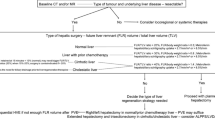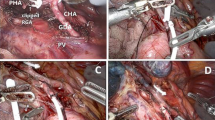Abstract
Background
The efficacy of infrahepatic inferior vena cava (IVC) semi-clamping for reducing blood loss during hepatic resection and its safety remain unclear. The aim of this study was to validate the effectiveness of IVC semi-clamping for reducing blood loss during hepatic resection and to confirm its safety.
Methods
Patients who underwent anatomical hepatic resection between January 2011 and May 2018 were analysed by propensity score-matched and multivariate analyses.
Results
Of 437 patients who underwent anatomical hepatic resection, IVC semi-clamping was performed in 196 patients (44.9%; clamping group). A propensity score-matched analysis demonstrated that even though there was no significant difference in the characteristics of the 141 patients in each group, IVC semi-clamping reduced the blood loss during hepatic resection (clamping group versus non-clamping group: 836 ± 123 vs. 1198 ± 124 ml, P = 0.04). Regarding post-operative complications, the multivariate analysis identified IVC semi-clamping as an independent risk factor for acute kidney injury on post-operative day 1 (P = 0.01, odds ratio = 9.23). A significant positive correlation was found between the duration of IVC semi-clamping and an increased level of serum creatinine (sCre) (P = 0.03), and a significant inverse correlation was found between the blood pressure after clamping and an increased level of sCre (P = 0.02). A receiver operating characteristic analysis revealed the duration and mean blood pressure after clamping that indicated a high risk of acute kidney injury to be 116 min and 65 mmHg, respectively.
Conclusion
IVC semi-clamping can reduce blood loss during hepatic resection but still necessitates monitoring in order to avoid acute kidney injury.


Similar content being viewed by others
References
Yanaga K, Kanematsu T, Takenaka K et al (1988) Hepatic resection for hepatocellular carcinoma in elderly patients. Am J Surg 155:238–241
Nagao T, Inoue S, Goto S et al (1987) Hepatic resection for hepatocellular carcinoma. Clinical features and long-term prognosis. Ann Surg 205:33–40
Jamieson GG, Corbel L, Campion JP et al (1992) Major liver resection without a blood transfusion: is it a realistic objective? Surgery 112:32–36
Yamamoto J, Kosuge T, Takayama T et al (1994) Perioperative blood transfusion promotes recurrence of hepatocellular carcinoma after hepatectomy. Surgery 115:303–309
Belghiti J, Noun R, Malafosse R et al (1999) Continuous versus intermittent portal triad clamping for liver resection: a controlled study. Ann Surg 229:369–375
Makuuchi M, Mori T, Gunven P et al (1987) Safety of hemihepatic vascular occlusion during resection of the liver. Surg Gynecol Obstet 164:155–158
Man K, Fan ST, Ng IO et al (1997) Prospective evaluation of Pringle maneuver in hepatectomy for liver tumors by a randomized study. Ann Surg 226:704–711
Yamamoto Y, Ikoma H, Morimura R et al (2014) Predictive scoring system assessing the need for intraoperative blood transfusions during hepatectomy for hepatocellular carcinoma. Anticancer Res 34:313–318
Yamamoto Y, Shimada K, Sakamoto Y et al (2011) Preoperative identification of intraoperative blood loss of more than 1,500 mL during elective hepatectomy. J Hepatobiliary Pancreat Sci 18:829–838
Huguet C, Addario-Chieco P, Gavelli A et al (1992) Technique of hepatic vascular exclusion for extensive liver resection. Am J Surg 163:602–605
Melendez JA, Arslan V, Fischer ME et al (1998) Perioperative outcomes of major hepatic resections under low central venous pressure anesthesia: blood loss, blood transfusion, and the risk of postoperative renal dysfunction. J Am Coll Surg 187:620–625
Bismuth H, Castaing D, Garden OJ (1989) Major hepatic resection under total vascular exclusion. Ann Surg 210:13–19
Rahbari NN, Koch M, Zimmermann JB et al (2011) Infrahepatic inferior vena cava clamping for reduction of central venous pressure and blood loss during hepatic resection: a randomized controlled trial. Ann Surg 253:1102–1110
Otsubo T, Takasaki K, Yamamoto M et al (2004) Bleeding during hepatectomy can be reduced by clamping the inferior vena cava below the liver. Surgery 135:67–73
Ueno M, Kawai M, Hayami S et al (2017) Partial clamping of the infrahepatic inferior vena cava for blood loss reduction during anatomic liver resection: a prospective, randomized, controlled trial. Surgery 161:1502–1513
Kato M, Kubota K, Kita J et al (2008) Effect of infra-hepatic inferior vena cava clamping on bleeding during hepatic dissection: a prospective, randomized, controlled study. World J Surg 32:1082–1087. https://doi.org/10.1007/s00268-007-9445-0
Couinaud C (1957) Etudes Anatomiques et Chiugicales. Masson, Paris, pp 400–409
Okamura Y, Ito T, Sugiura T et al (2014) Anatomic versus nonanatomic hepatectomy for a solitary hepatocellular carcinoma: a case-controlled study with propensity score matching. J Gastrointest Surg 18:1994–2002
Makuuchi M, Hasegawa H, Yamazaki S (1985) Ultrasonically guided subsegmentectomy. Surg Gynecol Obstet 161:346–350
Yamamoto Y, Ikoma H, Morimura R et al (2014) Clinical analysis of anatomical resection for the treatment of hepatocellular carcinoma based on the stratification of liver function. World J Surg 38:1154–1163. https://doi.org/10.1007/s00268-013-2369-y
Imamura H, Kokudo N, Sugawara Y et al (2004) Pringle’s maneuver and selective inflow occlusion in living donor liver hepatectomy. Liver Transpl 10:771–778
Khwaja A (2012) KDIGO clinical practice guidelines for acute kidney injury. Nephron Clin Pract 120:c179–c184
Jones RM, Moulton CE, Hardy KJ (1998) Central venous pressure and its effect on blood loss during liver resection. Br J Surg 85:1058–1060
Hasegawa K, Takayama T, Orii R et al (2002) Effect of hypoventilation on bleeding during hepatic resection: a randomized controlled trial. Arch Surg 137:311–315
Evans PM, Vogt DP, Mayes JT 3rd et al (1998) Liver resection using total vascular exclusion. Surgery 124:807–813
Uchiyama K, Ueno M, Ozawa S et al (2009) Half clamping of the infrahepatic inferior vena cava reduces bleeding during a hepatectomy by decreasing the central venous pressure. Langenbeck’s Arch Surg Dtsch Ges Fur Chir 394:243–247
Chertow GM, Burdick E, Honour M et al (2005) Acute kidney injury, mortality, length of stay, and costs in hospitalized patients. J Am Soc Nephrol 16:3365–3370
Lassnigg A (2004) Minimal changes of serum creatinine predict prognosis in patients after cardiothoracic surgery: a prospective cohort study. J Am Soc Nephrol 15:1597–1605
Zhou YM, Sui CJ, Zhang XF et al (2016) Anterior approach combined with infrahepatic inferior vena cava clamping right hepatic resection for large hepatocellular carcinoma: a prospective randomized controlled trial. Medicine 95:e4159
Lalu MM, Fayad A, Ahmed O et al (2015) Ultrasound-guided subclavian vein catheterization: a systematic review and meta-analysis. Crit Care Med 43:1498–1507
Author information
Authors and Affiliations
Corresponding author
Ethics declarations
Conflict of interest
All authors have no conflicts of interest or financial to disclose.
Informed consent
The study was approved by the institutional review board, and each study subject provided their written informed consent.
Additional information
Publisher's Note
Springer Nature remains neutral with regard to jurisdictional claims in published maps and institutional affiliations.
Rights and permissions
About this article
Cite this article
Imamura, T., Yamamoto, Y., Sugiura, T. et al. Infrahepatic Inferior Vena Cava Semi-Clamping can Reduce Blood Loss During Hepatic Resection but Still Requires Monitoring to Avoid Acute Kidney Injury. World J Surg 43, 2038–2047 (2019). https://doi.org/10.1007/s00268-019-04992-2
Published:
Issue Date:
DOI: https://doi.org/10.1007/s00268-019-04992-2




